“With handclaps and foot stamps provided by the audience”
**New 3 Feb 00**
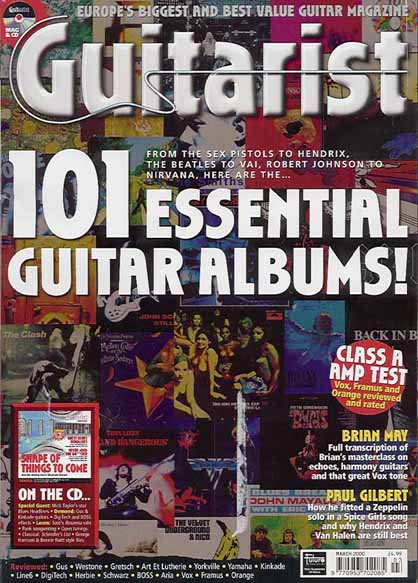
img1
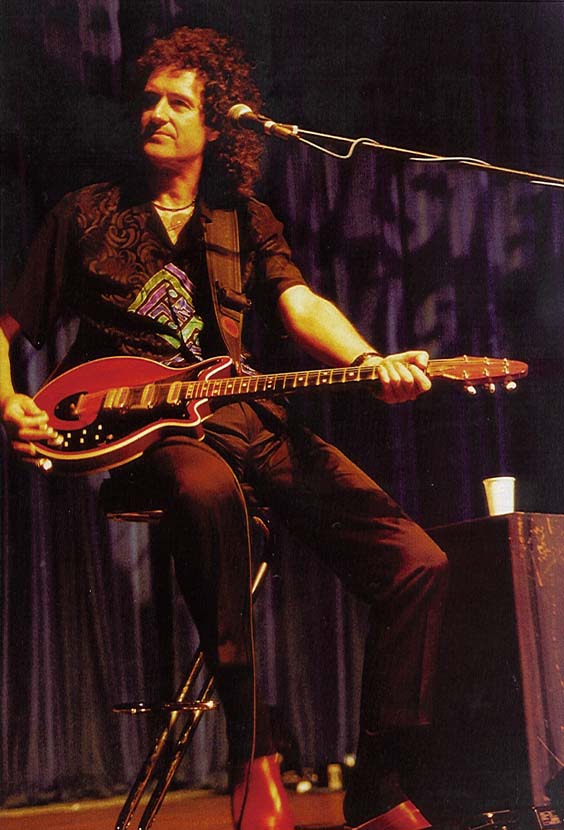
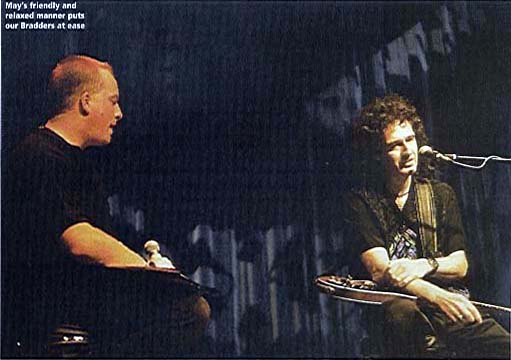
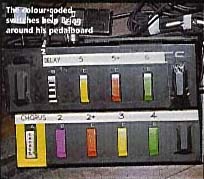
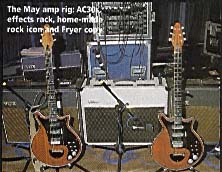
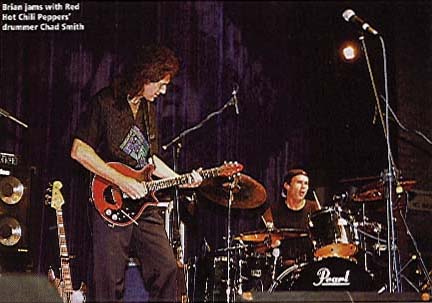
Don’t Stop Me Now
Brian May’s appearance at 1999’s National Music Show was met with such reverence that we’ve decided to revisit his unique, on-stage masterclass, hosted by Simon Bradley.
AS AN AVID READER of guitar magazines since the year dot, I was always both fascinated and envious when I read – more often than not in Yank publication Guitar Player – that Steve Vai, or whoever, would be appearing in Rawk Disc Records, Sunset Boulevard to play a one-off performance featuring all his licks, tricks and flicks.
Occasions such as that never seemed to happen in this country and I wished I could afford the airfare to Los Angeles just to see what a real guitar hero looked like up close and improvisational.
These days, thanks to the furious workload that is part of putting together th best guitar mag in the world, I’ve met many of my biggest heroes; Vai, Joe Perry, Angus Young, Paul Stanley, Ace Frehley, Live’s Chad Taylor, Skunk Anansie’s Ace, Tony Iommi – the list goes on and on.
However, this selection of the brightest stars of the music world pale in comparison to crossing paths with Brian May. This guy is the reason I started playing the guitar in the first place and although I do feel just the slightest fluttering of the butterflies before each and every interview I’ve ever undertaken for Guitarist, I produced a veritable hodfull of blue bricks as we pulled into the front drive of Brian May’s home for July 1998’s cover feature.
So, when Brian graciously agreed to appear at last year’s National Music Show for a one-off, 45-minute live masterclass, I was struck by a host of different feelings: our American readers would be jealous as hell when they read about it – nice to finally turn the tables – but how was I going to be able to interview the man calmly in front of, as it turned out, over 2,000 people in Wembley’s Grand Hall?
Well, those of you who were there will remember the warmth, the humour and the presence of the man, while those of you who couldn’t make it really missed out on something special. (A beat-box version of We Will Rock You anyone? It happened!
So, here we have an abridged transcription of our that – free of nervous interjections from yours truly – which will serve as a reminder of a day that also saw Sir Paul of Gilbert and Chill’s drummer Chad Smith tread the NMS boards…
The old lady
Brian’s home-built guitar, which is arguably one of the biggest rock icons of them all, made an early appearance. Brian talked us through its somewhat complex switching system.
“Most pickups were wired in such a way on the commercial guitars that you couldn’t make full use of all the sounds you could get out of them. So I decided that I would have a separate switch and polarity changer for each pickup. What that meant was that I could turn each pickup around in polarity and cancel out some of the harmonics.
For instance, if I put the treble and middle pickup together they have a nice plummy sound, but if I turn either of them around, it sounds totally different, because some of the lower harmonics are cancelling out. I didn’t want to lose these types of sound, so I used this way of switching, which I think Fender actually copied on one of their guitars. Similarly, if I have the middle and neck together and have one of them back to front, it emphasises the harmonics so much that they leap out at things at high volume, and that became a favourite sound for me, for example on the solo from Bohemian Rhapsody.”
Vox AC30s
Naturally, Brian was also accompanied by a trio of AC30 combos…
“I discovered that AC30s were the thing, and I still love them – better than anything. For me they sound best if they’re just given that extra kick by this little treble booster. It doesn’t do anything as far as adding distortion of changing the sound, except to cut out a bit of the low end so that you can drive the amps a bit harder.
I’m pretty happy with stock AC30s, except that if they go on the road, they’re completely redone inside by this guy called Dave Peterson, who was actually on the team who invented these things, and he takes them to bits and puts them back together in a very simple way.
He gets rid of all the stuff that I don’t need, like the vibrato and brilliant channels, all the extra bits and pieces. He builds just a normal channel with just the basic tone controls; all the valves are in good quality seatings and instead of the printed circuit boards, everything is hard-wired. You can take them on the road and they don’t mess up.”
The sixpence
We all know that Brian uses a sixpence as a plectrum, but it’s not often he explains exactly why he does so…
“It’s a great help to use the coin as, depending how it’s orientated to the strings, it can produce a varying amount of additional articulation, and by that I mean when you can hear just one string peeping through the whole spectrum of the rest of it.
So, if the sixpence is turned parallel to the strings, it’s quite a soft effect, even though it’s a piece of metal. And if you turn it sideways, the serrated edge changes the sound quite dramatically. I’ve always preferred the coin to anything else, both for that reason and because it doesn’t ‘give’ between the string and your fingers. Sixpences are very cheap these days!”
The delays
Brian treated us to several renditions of his trademark delay solo pieces.
“Originally, I discovered, some time sitting around in Rockfield, that if you put an Echoplex in your system and turn off all the regeneration, you can just get one delay out of it. Echoplexes are very crude devices with a piece of tape that goes round and I started playing around and found that you could play along with the repeat that came back and it would be a very controllable situation.
These days we use digital delays because it’s easier, but I don’t think they actually sound as good, but Echoplexes are so unreliable when we’re out…
You can do several different things with it; it’s the whole ‘canon’ effect that Bach pursued so brilliantly. Then I thought, what if you could get two, so then you could get the three-part harmony thing, which was always my dream. There’s something about three guitars in harmony that has always stirred my loins and I just wanted to be able to it.
I got my first chance in the studio when we were in there doing the first album. There’s a couple of three-part harmonies on there, but to do it live is difficult. So we have two delays equally spaced which is easiest way to approach it, and then you can build up three-parts.
It’s just a neat trick and it always gives me a great pleasure, because you never know quite what’s going to happen; that’s the joy of it. You can pretend you know what you’re doing!”
Other toys
Brian May’s rack also features a pitch shifter or two…
“Nowadays a pitch shifter can give you a harmony right off the bat, bu the trouble is that it tends to be very rigid. If you have a harmoniser set to a major third, it can sound very sickly after a while.
So, I’ve had a few attempts at varying it, so I can step on things and make different intervals. I can go from a major third, minor third, the two bagpipes in unison effect and so on.
From there I can keep my major third, but I can put in a fifth as well, which is nice for one note but again you get sick of it after a while. It’s much better if you can change it as you go along and although I can do it with my set-up, you have to think with your feet as well as your hands, so it can get confusing.
These days, effects boxes are so cheap that you can easily do stuff with them, but it was very difficult when we started: there was no such thing as a harmoniser. So the delays were the first opportunity for me to do that on-stage.”
Boxing clever
In the early days, rumours abounded of Brian fitting a device into the cavity of his guitar. Mr May was happy to explain:
“I did have a distortion box in there, something called a Vox Distortion Booster. At one time I had it mounted inside the guitar because I thought I needed the extra fuzz and sustain, but this was befrore I had the AC30s. I had a variety of amps before. I think one of them was a Burns amp, but when I turned them up, they just distorted in a very unpleasant way.
I think Hendrix used something similar to this distortion booster on his first album and if you notice the sound that he got there, it’s actually not as good in any way as the sound that he was getting live. So after while I ditched the fuzz box, ‘cos I just preferred the natural sustain. I just liked the real thing that valves and speakers do.”
Copy cat chat
I asked Brian to talk about two of the more famous copies of his Red Special. Firstly, the guitar made by luthier John Birch, for years a stage spare that also appeared on several videos from the album ‘News Of The World’.
“[The John Birch] was the first copy I ever had made of this thing and it was always just a little lacking on tone. I think that was partly because the tremolo was a very lightweight affair and also the neck didn’t have that sustain. I had a particularly frustrating night – I think in Chicago sometime – and I’d broken a couple of strings on my guitar, so I picked up the John Birch and it just wouldn’t happen. So, in a rare fit of pique, I lobbed it over the back of the stage somewhere and nobody caught it.
Anyway, the bits were sent to Guild when we were thinking about making the Guild copies, and were never seen again; so I think somebody must have nicked them!”
Better known still are the models produced by American company Guild.
“I have no plans at the moment to reissue the BHM 1. They did two issues of the copies, of which the second was a lot better than the first – although they both had their good points – but various things happened. They were taken over by Fender and wherever the personnel changes you lose that closeness. They started putting out things that weren’t as we’d agreed so I didn’t want to renew the contract. I am open to offers though!”
Show should go on…
In the process of building their reputation as a live band, Queen have played in virtually every major city in the world. There must have been some sticky moments, haven’t there? “There were plenty; more than I could shake a stick at. The first time we ever played Las Vegas we had this Crown, it was something very grand.
So, at the beginning of the show the Crown was on the stage and before we came on there was loads of smoke build-up. There was a big We Will Rock You intro tape, and the audience was going for it. There were explosions, the Crown lifted off the stage and Fred would go out on one side for the first verse, and I would be over the other side playing the very magnificent rock star.
So that night I got out there and nothing happened! That’s one of the most deflating experiences any man could have!
The other funny thing with the Crown was in Holland. There were the big explosions, there were all the lights and all the smoke, and it lifted off, but one side was going up, while the other side was going down ‘Oh my God’. It was very funny; it looked something like the sinking of the Titanic!”
Brian finished off his appearance at the NMS with a performance of the solo from We Will Rock You with handclaps and food stamps provided by the audience, before leaving the stage to a deafening roar.
He got up later to jam with Chad Smith, and even a member of as big a band as the Red Hot Chilli Peppers was left speechless by the opportunity to play with the man.
A real experience for the lucky few who were there and a professional pinnacle for me – I wasn’t that nervous either. Well, not until it sank in later on…G
Brian’s set us up!
AS WELL AS THE CHAT… Brian’s appearance offered a rare opportunity to see the full amp rig up close. Maintained and operated by Pete ‘Catweazel’ Malandrone, Brian talked us through his personal set up.
“Basically, I love the sound of a chorus. What we do is split the input between three amps. One goes directly into one of them, and the other goes into a little splitter which goes into two delays. What it basically does is separate the amps out. So instead of these amps sounding like one, you get three sounding like they have some spatial resolution to them.
Also, if you feed the chorus back into the same amp, it’ll be great at low volume but at high volume it’ll all go into one mush and won’t be stereo any more. I always try to keep the effects separate from the first amp. As soon as an amp is driven to saturation, you can’t put more than one thing into it. Which is why we have the three amps.”
Simon Bradley
Guitarist
July 1998